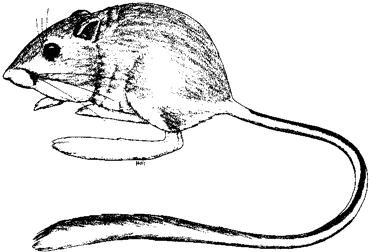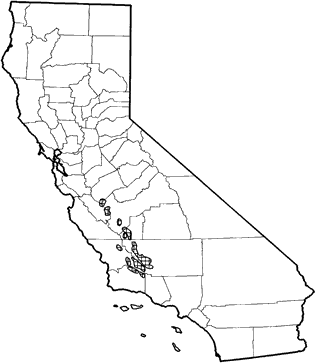
Giant Kangaroo Rat
Distribution, Abundance, and Seasonality
DISTRIBIJTION, ABUNDANCE, AND SEASONALITY Permanent resident occurring in scattered colonies along the western side of the San Joaquin Valley (e.g., Carrizo Plain, Panoche Valley). Found on fine sandy loam soils supporting sparse annual grass/forb vegetation, and marginally found in low-density alkali desert scrub. Currently occupies about 2% of its former range (California Dept. Fish and Game 1980a). Primary loss of habitat has been to cultivation. In addition, trampling of colonies by cattle and use of rodenticides have degraded habitats and reduced population levels.

Range Map
Specific Habitat Requirements
Feeding: Seeds of peppergrass and filaree are primary foods of giant kangaroo rats (Shaw 1934). Green vegetation also is consumed, especially spring. Seeds are buried in small, shallow holes winter and spring where they dry. Large quantities of dried seeds are cached in the burrows (Shaw 1934).
Cover: Level terrain and sandy loam soils are needed for burrowing. Optimal cover consists of areas with almost no shrub overstory, and very few physiographic variations (Grinnell 1932, Shaw 1934, Hawbecker 1951). Burrow systems (Shaw 1934) may cover an area of 5.2 x 6.7 m (17 x 22 ft).
Reproduction: Level terrain and sandy loam soils are required for excavating burrows and nests.
Water: Drinking water apparently is not required.
Pattern: Insufficient data available. D. ingens appears to require fairly large areas of homogenous terrain, with only scattered shrubs, but with an open, herbaceous cover of annual forbs and grasses.
Species Life History
Activity Patterns: Yearlong nocturnal activity.
Seasonal Movements / Migration: Non-migratory.
Home Range: Williams (1980) reported a population density of 52/ha (21/ac).
Territory: Little information available. The area immediately adjacent to the burrow, where surface caches of seeds are stored, may be defended, as is common in kangaroo rats.
Reproduction: Breeds from January to May; peak probably occurs in early spring. Litter size ranges from 4-6. Young born and reared in the burrows.
Niche: D. ingens is the largest species in the Genus Dipodomys; in optimal habitat it probably is the dominant nocturnal rodent. It is sympatric with Onychomys torridus, a nocturnal arthropod eater, and Ammospermophilus nelsoni, a diurnal eater of green vegetation and arthropods. Predators include kit foxes, badgers, coyotes, barn owls, rattlesnakes, and gopher snakes. Insects and birds potentially are competitors for seeds.
Sources & References
California Department of Fish and Game, 1999.
California's Wildlife, Sacramento, CA.
Written by: G. Ahlborn, reviewed by: M. White, edited by: M. White
Asdell, S. A. 1964. Patterns of mammalian reproduction. 2nd ed. Cornell Univ. Press, Ithaca, Ny. 670pp. California Department of Fish and Game. 1980a. At the crossroads: a report on the status of California's endangered and rare fish and wildlife. Sacramento. 149pp. Grinnell, J. 1922. A geographical study of the kangaroo rats of California. Univ. Calif. Publ. Zool. 24:1-124. Grinnell, J. 1932. Habitat relations of the giant kangaroo rat. J. Mammal. 13:305-320. Hawbecker, A. C. 1944. The giant kangaroo rat and sheep forage. J. Wildl. Manage. 8:161-165. Hawbecker, A. C. 1951. Small mammal relationships in an Ephedra community. J. Mammal. 32:50-60. Shaw, W. T. 1934. The ability of the giant kangaroo rat as a harvester and storer of seeds. J. Mammal. 15:275-286. Williams, D. F. 1980. Distribution and population status of the San Joaquin antelope squirrel and giant kangaroo rat. Calif. Dep. Fish and Game, Sacramento. Nongame Wildl. Invest. Final Rep. E-W-4, IV-10.1. 46pp.
California Animal Facts | California's Wildlife